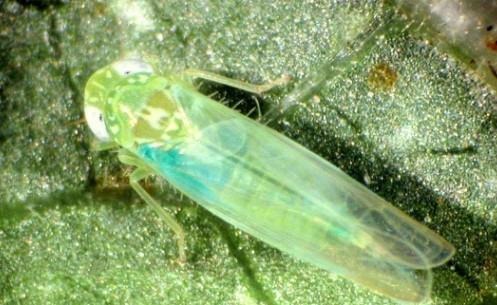 Potato leafhopper (Photo by Jim Kalisch)
Potato leafhopper (Photo by Jim Kalisch)
If you have not yet started to scout for potato leafhopper, now would be a good time to begin.
These small (1/8 inch long), bright green, wedge-shaped insects may cause severe damage to alfalfa. This feeding results in a distinctive yellow or purple triangle shape at the leaf tip. First year, spring planted alfalfa fields are particularly attractive to and vulnerable to potato leafhoppers, as are fields planted last year. In older fields, these insects are usually a problem on second and third cuttings.
Resistant varieties provide fairly good protection from potato leafhoppers, but alfalfa in the seedling stage may still be damaged. All fields should still be scouted, as large numbers of leafhoppers may still cause a problem, even in resistant variety fields.
Treatment Thresholds and Insecticides
Treatment decisions are based on numbers captured by a sweep net. (A sweep net is the only reliable way to scout for potato leafhoppers.) See Tables 1-3 for decision-making help. Note that there do not have to be many to cause a problem.
Many insecticides are registered for control, and all will provide good results when applied properly. Commonly used insecticides include Mustang, Warrior, Baythroid, and Lorsban, or products with the same active ingredients.
Refer to the UNL Extension Circular 130 for a list of suggested insecticides.
Table 1. Dynamic treatment thresholds for potato leafhoppers (average number per sweep) on alfalfa that is 1 to 4 inches tall. |
Value of hay (per ton) | Cost of insecticide application (per acre) |
| $8 | $10 | $12 | $14 | $16 | $20 |
|
$ 60 | 0.4 | 0.5 | 0.6 | 0.7 | 0.8 | 1.0 |
$ 80 | 0.3 | 0.4 | 0.5 | 0.5 | 0.6 | 0.75 |
$100 | 0.25 | 0.3 | 0.4 | 0.4 | 0.5 | 0.6 |
$120 | 0.2 | 0.25 | 0.3 | 0.35 | 0.4 | 0.5 |
$140 | 0.2 | 0.2 | 0.25 | 0.3 | 0.3 | 0.4 |
$160 | 0.15 | 0.2 | 0.3 | 0.3 | 0.3 | 0.4 |
Table 2. Dynamic treatment thresholds for potato leafhoppers (average number per sweep) on alfalfa that is 4 to 8 inches tall. |
Value of hay (per ton) | Cost of insecticide application (per acre) |
| $8 | $10 | $12 | $14 | $16 | $20 |
|
$ 60 | 0.7 | 0.8 | 1.0 | 1.0 | 1.3 | 1.7 |
$ 80 | 0.6 | 0.6 | 0.75 | 0.9 | 1.0 | 1.3 |
$100 | 0.4 | 0.5 | 0.6 | 0.7 | 0.8 | 1.0 |
$120 | 0.3 | 0.4 | 0.5 | 0.6 | 0.7 | 0.8 |
$140 | 0.3 | 0.35 | 0.4 | 0.5 | 0.6 | 0.7 |
$160 | 0.25 | 0.3 | 0.4 | 0.4 | 0.5 | 0.6 |
Table 3. Dynamic treatment thresholds for potato leafhoppers (average number per sweep) on alfalfa that is 8 to 12 inches tall. |
Value of hay (per ton) | Cost of insecticide application (per acre) |
| $8 | $10 | $12 | $14 | $16 | $20 |
|
$ 60 | 2.0 | 2.4 | 2.8 | 3.0 | 3.9 | 5.0 |
$ 80 | 1.8 | 1.9 | 2.2 | 2.7 | 3.0 | 4.0 |
$100 | 1.2 | 1.5 | 1.8 | 2.1 | 2.4 | 3.0 |
$120 | 0.9 | 1.2 | 1.5 | 1.8 | 2.1 | 2.4 |
$140 | 0.9 | 1.0 | 1.2 | 1.5 | 1.8 | 2.0 |
$160 | 0.8 | 0.9 | 1.0 | 1.2 | 1.5 | 1.8 |
|
Source : unl.edu